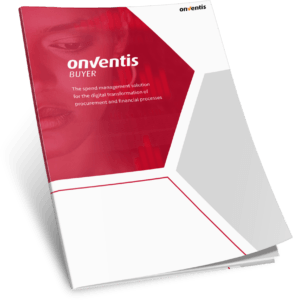Software for Procurement: Our Guide to Your Right S2P Solution
Companies that want to succeed in today’s environment must maintain control of their entire procurement cycle, from demand identification to invoice payment. Choosing the right software for procurement can significantly impact the efficiency and success of your procurement operations. That’s where the source-to-pay concept comes in, providing a one-stop shop for all phases of the procurement process.
But how do you find the perfect solution in a market dominated by a wide range of vendors and options? What questions should you ask yourself to ensure you select the suite that best fits your specific needs and goals?

Software for Procurement: Our Guide to Your Right S2P Solution
Companies that want to succeed in today’s environment must maintain control of their entire procurement cycle, from demand identification to invoice payment. Choosing the right software for procurement can significantly impact the efficiency and success of your procurement operations. That’s where the source-to-pay concept comes in, providing a one-stop shop for all phases of the procurement process.
But how do you find the perfect solution in a market dominated by a wide range of vendors and options? What questions should you ask yourself to ensure you select the suite that best fits your specific needs and goals?
In this blog, we will provide you with comprehensive guidelines to help organizations identify the optimal vendor for your source-to-pay requirements. We will raise important questions to consider when making your selection and provide valuable insights into the decision-making process. This list will guide you in finding the most suitable software for purchasing that best covers your requirements and desires. In addition, we provide important aspects that should not be missing in any decision-making process to ensure a smooth implementation and master digital transformation!
Key takeaways:
- Current standing of the company and future requirements: The starting point for selecting an S2P solution is a clear inventory of existing procurement processes and defining objectives.
- Problem areas: Identify the areas with the biggest challenges and issues in your supply chain. Prioritize the functions that are most relevant to address the identified issues.
- Compare providers: Create a complete overview of the services, features, and technical details of different S2P vendors. Look for adaptability, data integration, ease of use, and customer support from the vendor.
- Costs and ROI: Consider all costs, including implementation and ongoing maintenance, and evaluate the expected return on investment (ROI).
- Scalability: Ensure that the S2P solution you choose can keep pace with the growth and changing needs of your business.
- Support and training: Pay attention to the customer support provided, especially training and education, to ensure acceptance and effective use of the software.
- Customer references and testimonials: Leverage experiences of other companies to evaluate the quality and experience of the vendor. Research references, testimonials, case studies, and best practices to learn the actual results and benefits of the S2P software first-hand.
Our checklist for choosing the right procurement software
1. Current Status of the Company and Future Requirements: Taking Stock Before Making a Choice
Before you start down the path to digitalization and choose an S2P suite, it’s important to know the current state of your business. This step lays the foundation for the entire selection process. Start by taking an in-depth look at your existing procurement processes. Then, clearly define your goals: What areas of your procurement could be optimized? This could be in speeding up approval processes, reducing costs, improving supplier selection, or strengthening compliance. Make sure your objectives are clearly defined, quantifiable, and measurable. It is important to determine which functions and features in the new solution are critical for your company.
However, you should not only consider your current needs, but also consider the future. Analyzing your current state and clearly defining your future requirements are the starting point for selecting the right S2P provider. Only when you understand your needs and goals, you can specifically look for a solution that meets these requirements and supports your company on the path to successful procurement.
2. Identify Problem Areas
Now that you’ve identified your requirements, it’s time to focus on the problem areas and challenges you want to solve with an S2P suite. To do this, identify the areas where implementing procurement software would add the most value. What processes and procedures in your supply chain are currently causing the most problems? For example, are there inefficient approval processes, difficulties in supplier selection, or a lack of transparency in procurement processes? By identifying problems, you can ensure that the solution is first implemented where the need is greatest.
You should then prioritize essential functions for your company to overcome the identified problems. The target-actual comparison of your processes conducted earlier can serve as a guide to determine the most relevant functions for this purpose. This will ensure that you address the implementation purposefully and that the S2P solution can effectively deal with your specific challenges.
3. Compare Providers: Technical Details
The vendor comparison marks a crucial phase in selecting your ideal software for procurement. This involves evaluating the technical details and capabilities of the various vendors and ensuring that the solution fits your needs. It should be done thoroughly and can be conducted in several stages:
Overview of services: Create a comprehensive overview of the services and features offered by the various S2P providers. You should pay particular attention to which aspects best meet your specific needs. This overview will serve as your basis for comparison.
Adaptability and flexibility: Every company is unique and has specific requirements. Accordingly, adapting standardized software solutions to individual business processes is essential. Flexibility in dealing with various interfaces and already established systems is imperative to ensure seamless software integration into business processes. In this context, procurement managers should ask whether it is possible to create customized workflows and approval processes to make optimal use of the software’s automation while adapting it to their specific requirements.
Data integration: A key question when selecting an S2P solution involves data integration: How efficiently can the S2P software be integrated into existing ERP or other systems? Does it provide seamless data transfer capabilities? Data inconsistencies and problematic data transfers are key chokepoints in the world of procurement. Since smooth data integration is critical to ensure seamless collaboration across the team, addressing the above issues is vital.
User interface: Buyers should take the time to experience the software through demonstrations and test itsusability. The software should simplify and facilitate daily business operations. Therefore, you should ensure that the user interface is easy and intuitive to use. This contributes to the acceptance and effectiveness of the software.
Customer support: After the implementation of the software, various challenges will inevitably arise. Technical issues and other difficulties are ever-present. Therefore, make sure that the provider offers sufficient customer support to respond to these concerns. Customer service quality, response times, and how the company resolves other customers’ issues are critical factors in evaluating customer support. From this, the company can draw conclusions about whether the provider handles its requests effectively and in a targeted manner.
4. Costs and ROI
The next step is to take a closer look at the financial aspects. In addition to the technical details, the focus should also be on the costs. This includes all expenses related to the solution’s introduction, implementation, and maintenance. Both running costs and any additional expenses associated with implementing and adapting the software to the company must be considered.
On the other hand, there are cost savings: What financial benefits does the software offer when it is put into operation? The added value of the solution should be compared with the costs. In this context, you should check whether there are ways to quantify the ROI in order to answer the question of profitability in a data-based manner.
Analyzing the costs and ROI ensures that the investment in the source-to-pay solution makes sense not only technically but also financially. This step helps keep an eye on the total cost of ownership of the software solution while evaluating the business value and return on investment.
5. Scalability
As companies constantly change and grow, a carefully selected solution that fits the requirements now may not be sufficient later. To address this challenge, buyers should consider the ability of the solution to grow with the size and structure of the business during the selection process. Is the software scalable to support the growth of the business? A long-term solution should meet the business’s current and future needs.
It is also recommended to take a close look at the provider’s roadmap: Will regular updates and new functions be available in the future? How well are they prepared for technological developments and changes in the industry? These questions ensure that the selected S2P solution will meet the needs of the company today and tomorrow. The scalability of the software indicates whether it can grow with your company and will also be useful to you later.
6. Support And Training
The implementation phase of a new solution rarely comes without challenges, as the business goes through significant change and must adapt to the new processes. To simplify this transition, it’s important to consider the type of support offered by the provider both during the implementation and in ongoing operations when selecting a supplier. It’s also important to ensure that the new solution can be used to the fullest extent. Training is the key factor in making sure that implementation is effectiveand that employeescan use the software efficiently, productively, and independently.
7. Customer References And Testimonials
In addition to all the technical questions and the cost breakdown, check out other companies’ experiences with the vendor and the solution. Insights and feedback from reference customers can be extremely valuable at this stage. They can be used to assess the vendor’s experience and determine if they have successfully met similar needs before. Before deciding, conduct reference research to access testimonials, case studies, or even direct contact with existing customers if necessary. You can also ask the vendor for insights into best practices applied to similar projects.
Conclusion: Finding The Right Source-To-Pay Suite For Your Business
Selecting a source-to-pay suite is a critical task that will significantly impact your company’s efficiency and cost control. After carefully considering these questions, you will be equipped to select the most appropriate vendor for your source-to-pay suite. Remember, this process takes time and resources, but it’s worth the investment. A well-chosen S2P solution can significantly benefit your business and help streamline your sourcing and procurement processes.
For further assistance and guidance in selecting your source-to-pay suite, you can contact our digital procurement professionals and experts. They will be happy to assist you to ensure that your selection meets the needs of your business.
Weitere BlogsMore BlogsMeer blogs




